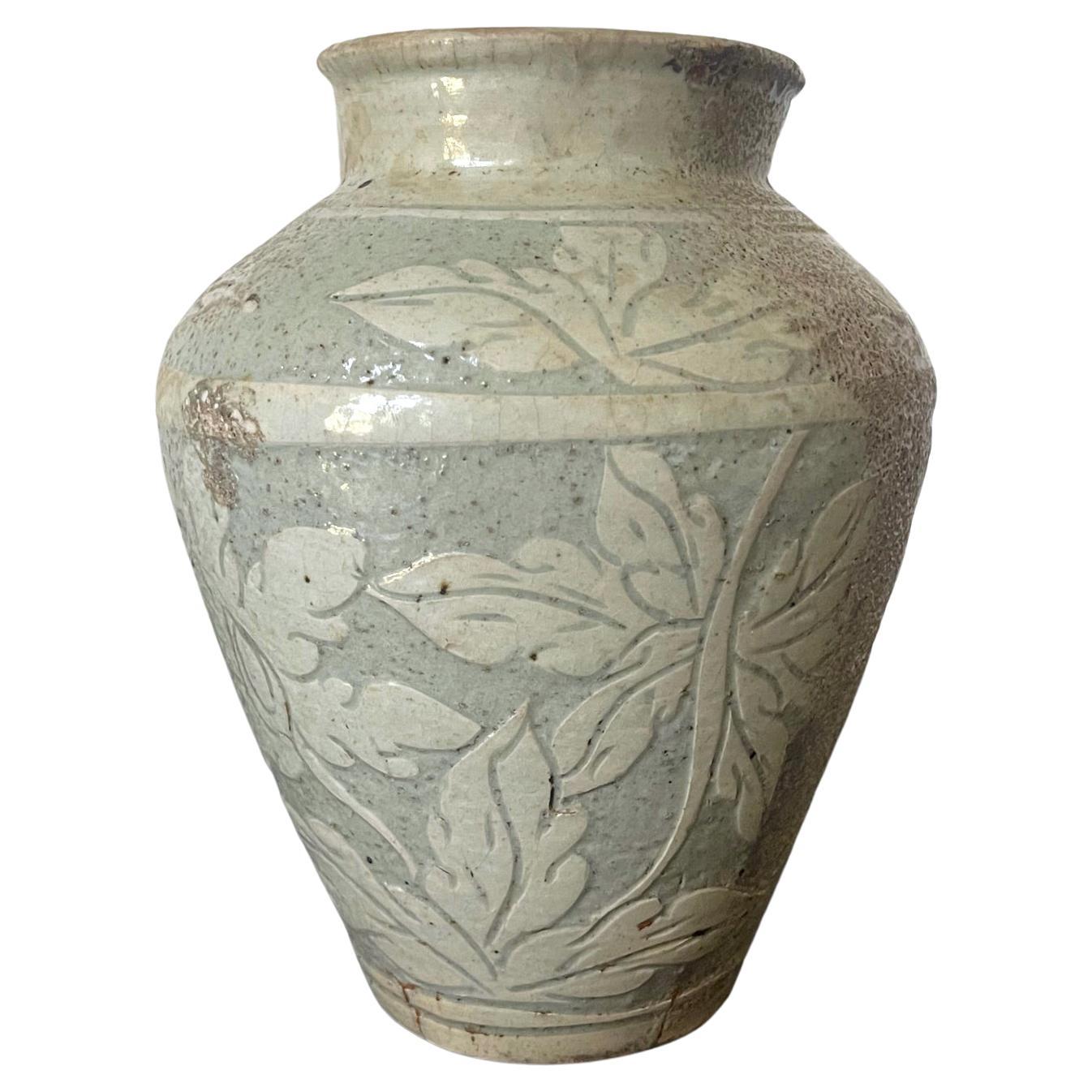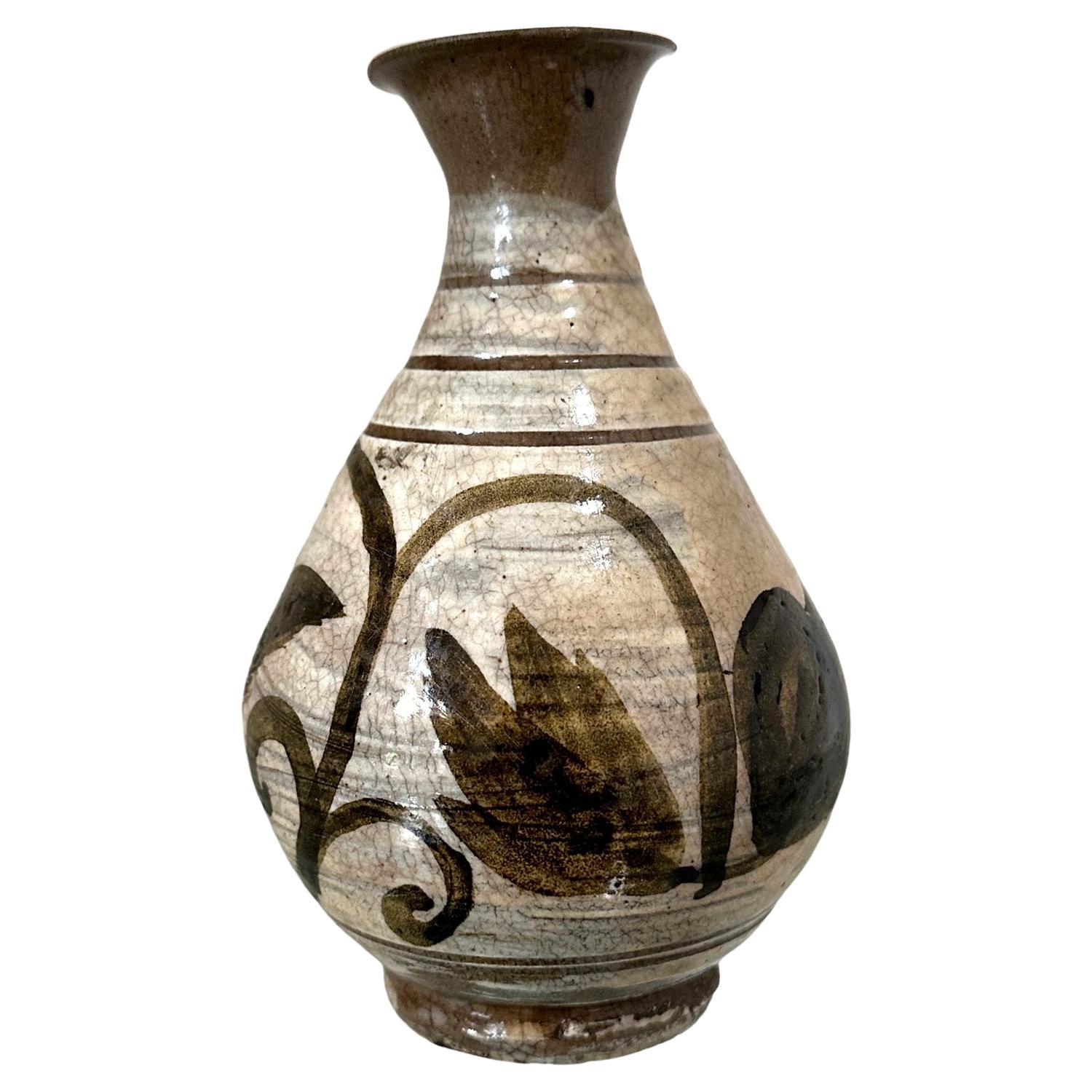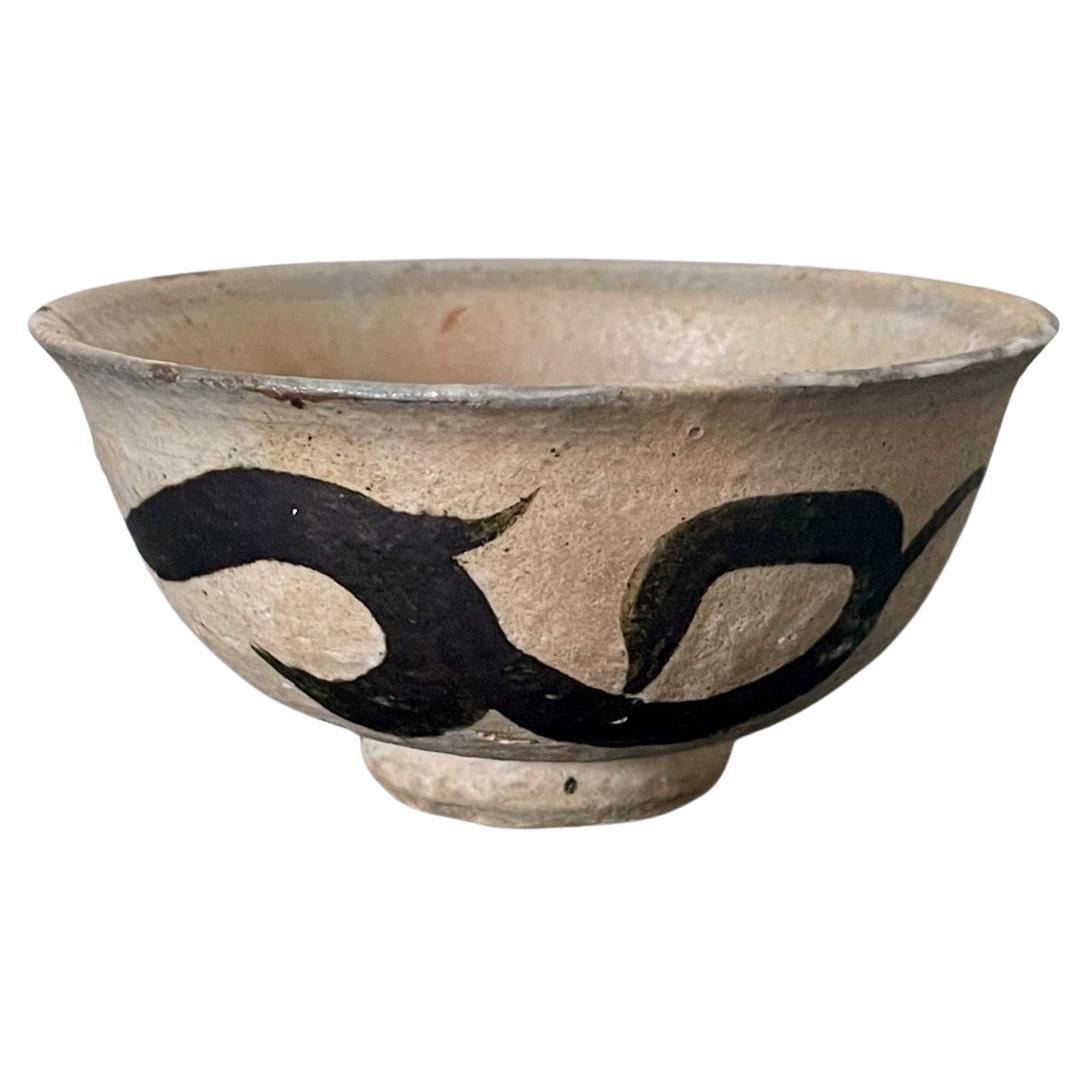Items Similar to Antique Korean Buncheong Flat Bottle Vase with Incised Designs
Want more images or videos?
Request additional images or videos from the seller
Antique Korean Buncheong Flat Bottle Vase with Incised Designs
About the Item
A Korean Buncheong stoneware vase circa 15th century of Joseon Dynasty. The robust vase with thick walls was made in a bottle form with rounded square contour and flattened surfaces. It was made as a utilitarian vessel and traditionally used to store liquid such as wine. The primary incised design on the front and back features an egret bird (or the like) perching on a tree branch with a fish caught in its beak. The imagery was confined to a double-lined roundel following the edge of the facade. The folky pictorial is full of dynamic energy and playful charm. On the sides of the vase, there are secondary design of incised cascading patterns, likely represent water. The shoulder is surrounded with sgraffito design of double-border peony petals. The execution of the decoration is rustic typical of Buncheong ware made in that period.
Buncheong ware was made in early Joseon Dynasty, transitioning from the iconic celadon ware of Goryeo Dynasty and preceding white porcelain production in the later Joseon period. Incision and surface carving (sgraffito) were the main techniques used for surface decoration. The stoneware was first fired in iron-brown underglaze which formed a background. Then it was covered in white slip, on which a preconceived design was created by incision and sgraffito to expose the dark underglaze. Finally, a transparent glaze was applied on top which shows tends to show small crackles throughout, as seen on this piece. Buncheong ware in the early period have a more robust body with simple, but effective design, as also exemplified in this piece. The base ring of the vase was not covered with white slip or glaze, exposing a rather dark sandy clay.
As often the case, there are flaws occurred in the making on this type of Buncheong ware. There are a couple of dark specks and a surface crack through the glaze on one side, occurred from the firing process. The transparent overglaze was uneven, pooling in places, causing color unevenness in some areas manifesting in a slightly redder hue. There is also a small chip of lost glaze happened sometime in its life, which perfectly exposed the dark iron-brown underglaze (a window to the making process so to speak). Despite, or in a way because, of these imperfections, the piece presents an earthy honesty and a strong wabi-sabi appeal.
Reference: A similar bottle with incised fish design is in the collection of National Museum of Korea (duk 2963); he collection of Honolulu Museum of Art (2522.1).
Compared to lot 505 In Sotheby's New York sale "SUBLIME BEAUTY: Korean Ceramics from a Private Collection" 22 September 2022
Lot 353 in Christie's. Japanese and Korean Art, New York, 19 March 2019.
- Dimensions:Height: 8 in (20.32 cm)Width: 7.5 in (19.05 cm)Depth: 6.5 in (16.51 cm)
- Style:Archaistic (Of the Period)
- Materials and Techniques:
- Place of Origin:
- Period:
- Date of Manufacture:15th Century
- Condition:Wear consistent with age and use. Minor losses. As noted in the description, kiln flaws and a small old glaze chip, also minute glaze losses around the mouth rim. Please examine all the detail photos carefully.
- Seller Location:Atlanta, GA
- Reference Number:1stDibs: LU945039455662
About the Seller
5.0
Platinum Seller
These expertly vetted sellers are 1stDibs' most experienced sellers and are rated highest by our customers.
Established in 2006
1stDibs seller since 2010
480 sales on 1stDibs
Typical response time: <1 hour
- ShippingRetrieving quote...Ships From: Atlanta, GA
- Return PolicyA return for this item may be initiated within 2 days of delivery.
More From This SellerView All
- Antique Korean Buncheong Ceramic Vase with Incised DesignsLocated in Atlanta, GAA Korean ceramic bottle form jar of Buncheong ware circa 15-16th century Joseon Dynasty. The surface of the jar features a celadon glaze and an elaborate incised design of large flor...Category
Antique 16th Century Korean Archaistic Ceramics
MaterialsCeramic
- Korean Glazed Ceramic Vase Buncheong Ware Early Joseon DynastyLocated in Atlanta, GAAn antique Korean Buncheong stoneware vase from early Joseon Dynasty circa late 15th to early 16th century. The vase is of a classic pear form with a ...Category
Antique 15th Century and Earlier Korean Archaistic Ceramics
MaterialsCeramic
- Antique Korean Celadon Bottle Vase Joseon DynastyLocated in Atlanta, GAA Korean ceramic bottle-form vase circa 16th century Joseon Dynasty. It was likely intended as a wine bottle, the pear-shaped vessel with flaring neck feature a celadon glaze exterio...Category
Antique 16th Century Korean Archaistic Ceramics
MaterialsCeramic
- Korean Caledon Vase Bottle with Kintsugi Repair Goryeo DynastyLocated in Atlanta, GAA ceramic wide-mouthed bottle vase covered in green celadon glaze from Goryeo dynasty circa 11-12th century. The bottle vase with such a form (mouth with wide rim, long and slender n...Category
Antique 15th Century and Earlier Korean Archaistic Ceramics
MaterialsCeramic
- Korean Glazed Ceramic Vase Buncheong Ware Joseon DynastyLocated in Atlanta, GAA small antique Korean Buncheong stoneware vase from early Joseon Dynasty circa 16th century. The vase is of a classic pear form with a waisted neck, a flared mouth and a ringed base...Category
Antique 16th Century Korean Other Ceramics
MaterialsCeramic
- Korean Ceramic Buncheong Ware Tea Bowl Early Joseon DynastyLocated in Atlanta, GAAn antique Korean Buncheong stoneware tea bowl (chawan) from early Joseon Dynasty circa late 15th to early 16th century. The bowl with a short ring base is nearly entirely covered in a white slip except the base (known as sougusuri in Japanese, total glaze). Iron-colored scrolling vines were painted on with quick and deft brush strokes, rendering the bowl a vital and spontaneous appeal. It appears that the bowl was dipped in the white slip instead of being brushed on, observing from the slip pattern left on the rim of the bowl. The bowl shows significant age and evident of use for tea drinking. There are losses of glaze flakes throughout, along the rim and inside the bowl. The flake off the glaze left a dark spot on the rim, exposing the deep colored clay underneath. Inside the bowl, many of the glaze flakes appear more superficial and retains a yellowing color from the tea stains (known as amamori, rain leak). There is a historical crack line on the exterior (surface only) that result in associated small losses of glaze. It appears that the crack line was the result from the kiln firing and gradually the glaze around it started to reduce. The bowl comes with a later wrapping cloth and a wood tomobako box, but they are not original to the piece. This particular type of Buncheong ware was associated with the Hakbong-ri kilns in the sacred Mount Gyeryong Mountains, west of Daejeon city in the Chungcheong province. During early Joseon Dynasty, the emperor decided to reject Buddhism to embrace the Confucianism. As a result, many monks were forced to abandon their religious life and returned to the secular society. The monks in Gyeryong mountains set up the kilns and started to produce this so called "Hakbong-ri" type of Buncheong ware. The production was shorted-lived for only a few decades from late 15th to early 16th century before it turned to porcelain, but the ware made during that period was noted for their fresh and enigmatic appeal with deft iron-paint decoration. Collectors cherish these rare pieces for their vitality and spontaneity often used them on important occasions of chado in Japan and passed down to generation. For a similar bowl, see Catalog 52 illustrated on page 87 of the book "Korean Buncheong Ceramics...Category
Antique 15th Century and Earlier Korean Archaistic Ceramics
MaterialsCeramic
You May Also Like
- Korean Buncheong Joseon Dynasty Glazed Pottery Ceramic Calligraphy VaseLocated in Studio City, CAA beautifully glazed and colored, hand-decorated Korean Buncheong vase. Joseon Dynasty (1392-1910). Very nice patina. We are listing it as 19th cent...Category
Antique 19th Century Korean Ceramics
MaterialsEarthenware
- Korean White Glazed Porcelain Bottle Vase, Joseon Dynasty, 19th Century, KoreaLocated in Austin, TXA subtle and elegant Korean Joseon Dynasty white glazed porcelain bottle vase, 19th century, Korea. The bottle vase with an unusual globular body, nar...Category
Antique 19th Century Korean Ceramics
MaterialsPorcelain
- Korean Goryeo Celadon Glazed Bottle Vase with Kintsugi Repair, 12th CenturyLocated in Austin, TXA sublime Korean celadon glazed cup mouth bottle vase, Goryeo Dynasty, 12th century, Korea. The elegant bottle vase, originally used to serve wine, features a gorgeous Goryeo celadon...Category
Antique 15th Century and Earlier Korean Ceramics
MaterialsStoneware
- Korean Goryeo Celadon Glazed Slip Inlaid Bottle Vase, 12th/13th Century, KoreaLocated in Austin, TXA delightful small Korean Goryeo ware celadon glazed stoneware bottle vase with sangam slip inlay, Goryeo Dynasty, 12th - 13th century, Korea. The sma...Category
Antique 15th Century and Earlier Korean Ceramics
MaterialsStoneware
- Kundika Bottle Celadon with Incised Flower / 12th Century / Korean AntiqueLocated in Kyoto-shi, KyotoA "Johin" is a vase used to hold pure and clean water. According to the ancient Buddhist scripture "Lotus Sutra," it was originally one of the 18 tools that Buddhist monks were required to possess, but later came to be used as a vessel for offering clean water to the Buddha. During Korea's Goryeo period, it was also commonly used as a water storage container. The vase is adorned with delicate floral patterns engraved with fine lines on its front and back. Among other Goryeo celadon...Category
Antique 15th Century and Earlier Korean Ceramics
MaterialsCeramic, Celadon
- Korean White Glazed Porcelain Bottle Vase, Joseon Dynasty, 18th CenturyLocated in Austin, TXA quiet and elegant Korean white glazed bottle vase, Joseon Dynasty, late 18th century, Korea. The graceful vase beautifully proportioned, resting on a short recessed foot, with a...Category
Antique Late 18th Century Korean Ceramics
MaterialsPorcelain
Recently Viewed
View AllMore Ways To Browse
19th Century Qing Porcelain
Japan Porcelain Ware
17th Century Enamel
Celadon Tea
Modern Couches 1940s
Set Bronze Vase
Brown Amber Murano
Mid Century Modern Lights Sputnik
Dining Table Extend Set
Mid Century Mirror Shelf
Flower Vase Lid
Corbusier Concrete Lamp
French Flower Candelabras
Table Top Plant Stand
20 Glass Bowl
China Porcelain Vase Rose
Murano Glass Bathroom Light
Vintage Persian Hamadan Rug





